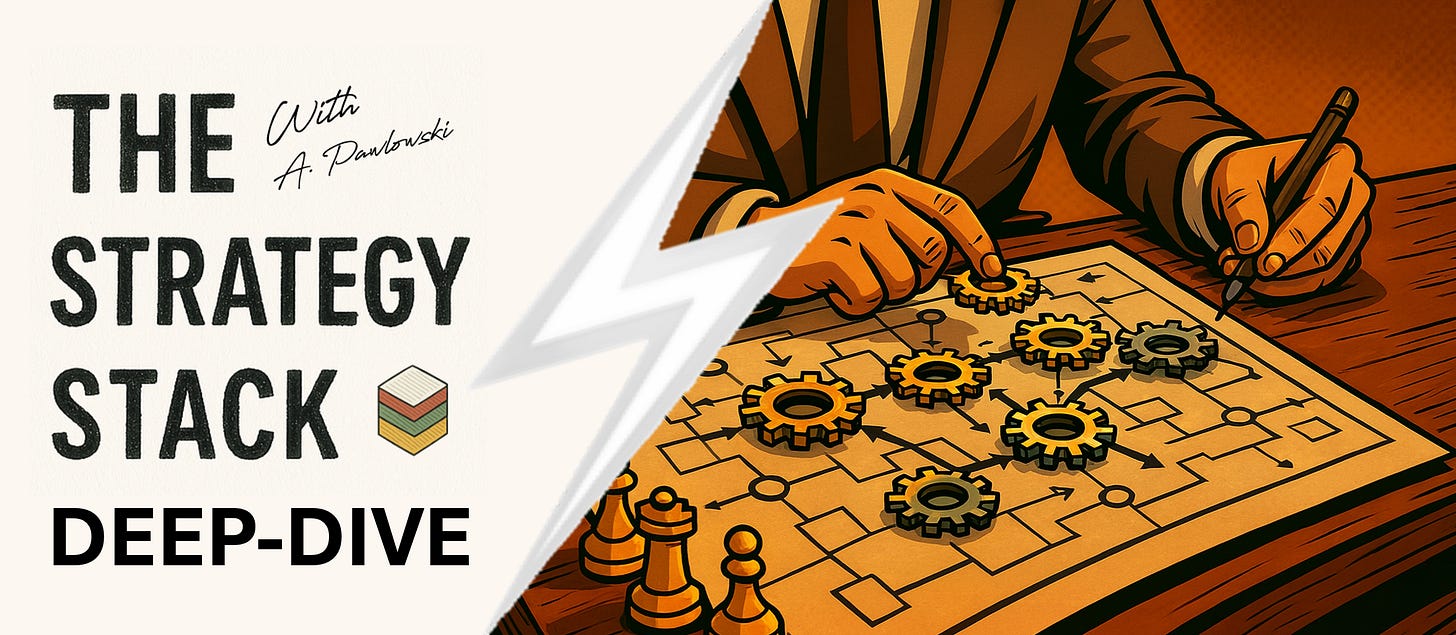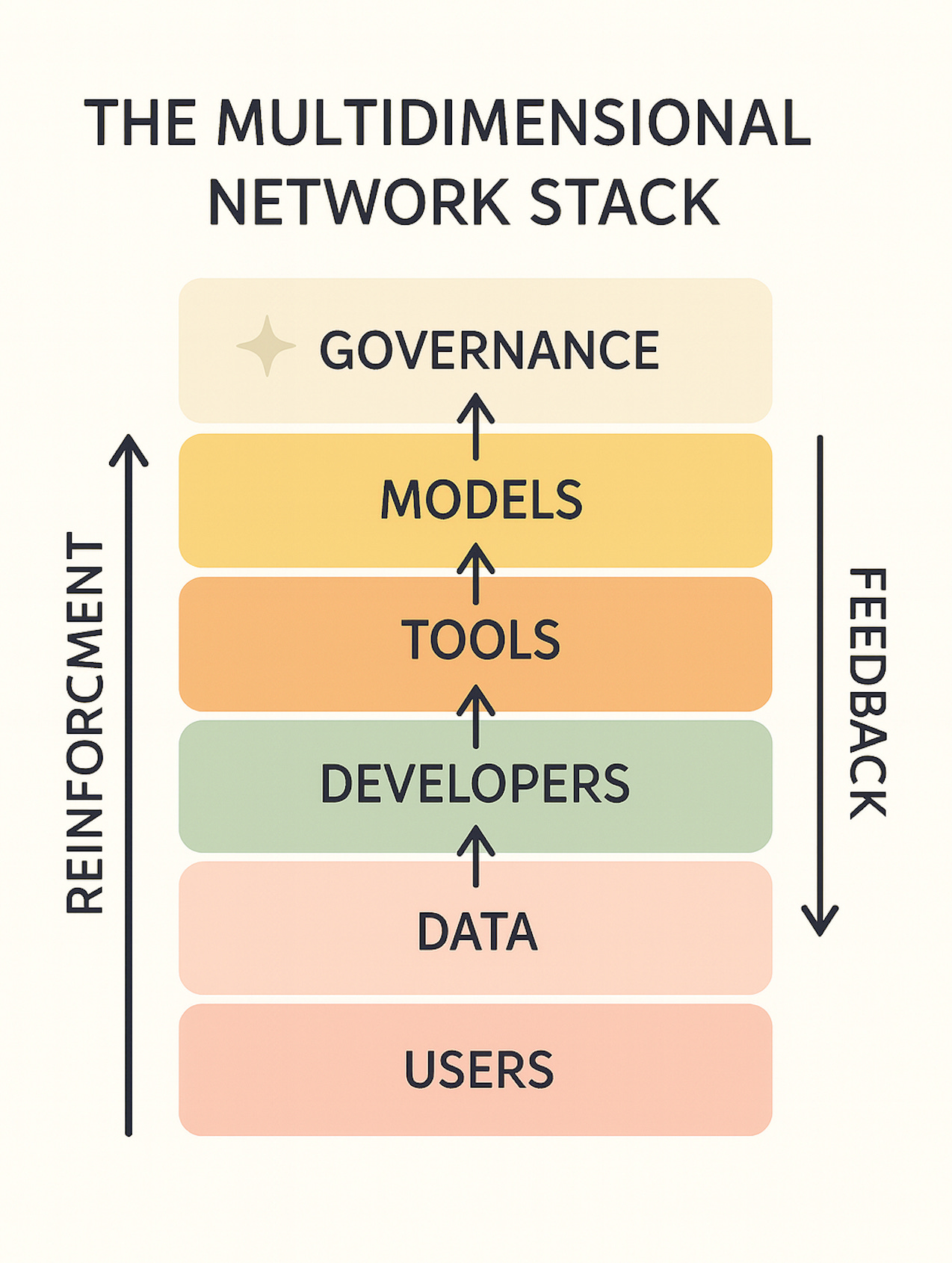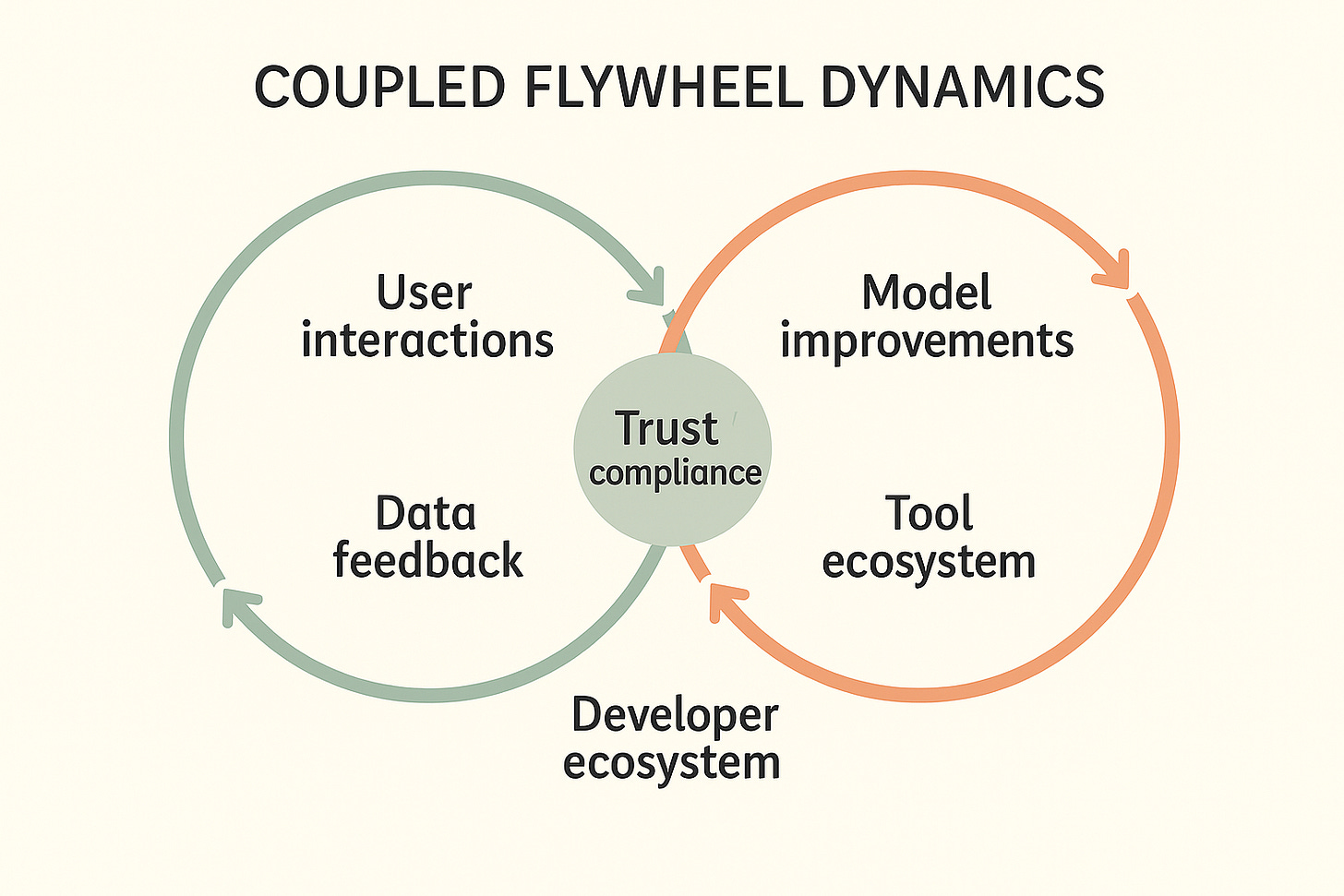Multidimensional Network Effects: How AI Platforms Really Scale
#127: Chapter 6: Network Effects & Systemic Flywheels - 6.1 Multidimensional Network Effects
If aggregators win by orchestrating demand, they scale by compounding network effects across dimensions — not users.
Classic network effects said:
more users → more value → more users.
In 2025, this shift reshapes platform economics entirely. AI platforms and modern aggregators no longer scale through participation alone — they scale through stacked system dynamics, where models, tools, data, developers, and governance reinforce each other.
The new rule:
Network Effects are no longer single-loop.
They’re multidimensional flywheels — stacked, coupled, and increasingly invisible.
TL;DR: Multidimensional Network Power = (Cross-Side Coupling × Feedback Velocity) ÷ Switching Elasticity
Table of Contents
Why Traditional Network Effects No Longer Explain Scale
The Four Dimensions of Modern Network Effects
Coupling: Where Flywheels Become Systems
Failure Modes: When Network Effects Turn Fragile
Strategic Guidance: Designing Multidimensional Moats
Closing Thought — From Network Effects to Network Governance
1. Why Traditional Network Effects No Longer Explain Scale
Platforms used to scale by building one dominant network loop:
Marketplaces: buyers ↔ sellers
Social: users ↔ users
SaaS ecosystems: developers ↔ customers
Search: queries ↔ documents
Those loops still matter.
But AI collapses them into stacked interaction layers.
In inference-driven systems, the value creation engine isn’t one network.
It’s a mesh of networks that reinforce each other.
Example:
A user prompts an assistant → model routes to a tool → tool produces outcome → user feedback improves model → developer optimizes tool → compliance layer constrains routing → new users trust the system → usage rises.
That’s not a loop.
That’s a systemic flywheel.
This is the new architecture of platform economics: multidimensional network effects operating as an integrated system rather than a traditional platform business model.
Figure 1 — The Multidimensional Network Stack
(Users × Data × Developers × Tools × Models × Trust/Compliance → coupled flywheels)
Strategic Insight:
If you’re still mapping network effects as a 2-sided marketplace, you’re playing 2015 chess in a 2025 war.
2. The Four Dimensions of Modern Network Effects
Multidimensional network effects happen when value compounds across distinct but connected sides.
Not all platforms have all four.
Winning AI-powered platforms do.
These dynamics also explain why modern aggregators outperform legacy platforms: they operate across more surfaces, coordinating users, data, developers, tools, and models through a unified system design.
Dimension 1: User–User Effects
Still foundational. Still real.
But now often indirect.
Users don’t always interact with each other — they interact through the model’s memory of everyone else.
More users → richer behavioral signals
Richer signals → better inference
Better inference → more users
Example: TikTok’s “you” feed, Perplexity’s retrieval tuning, ChatGPT personalization.
Users never meet. Their data does.
Dimension 2: User–Data Effects
Data is no longer “content.”
It’s training fuel + context supply + evaluation mesh.
More usage → more task diversity
More diversity → stronger generalization
Stronger generalization → broader usage
This creates data gravity flywheels:
not because data is large, but because it’s use-shaped.
Strategic Insight:
The most valuable data isn’t proprietary.
It’s interactional.
Dimension 3: Developer–User Effects
Developers expand capability surfaces.
Users validate them at scale.
More developers → more tools/GPTs/APIs
More tools → more reasons to use
More usage → more developer demand
More developer demand → more tools
Example:
OpenAI GPT Store, Shopify’s app ecosystem, Slack’s integrations — all now shifting toward agentic tooling.
The difference in 2025: tools are not add-ons. They’re co-pilots in the core loop.
Dimension 4: Model–Tool Effects
This is the new one.
And it’s the least understood.
Models get better when they have more tools to call.
Tools get better when models route more tasks to them.
Better model routing → higher tool usage
Higher tool usage → richer tool feedback
Richer tool feedback → improved tool performance
Improved tool performance → better model outcomes
These are recursive capability loops.
They turn a platform into a learning coordination system, not a product.
Figure 2 — The Model–Tool Recursion Loop
(Model quality ↔ tool ecosystem ↔ task success ↔ routing confidence ↔ model quality)
3. Coupling: Where Flywheels Become Systems
A single network loop scales linearly.
A coupled network system compounds non-linearly.
Coupling happens when:
a gain in one dimension
causes a gain in another
which then reinforces the first
That’s systemic flywheel lock-in.
In system dynamics terms, this is where aggregator theory converges with platform economics: tightly coupled loops generate nonlinear scale advantages.
Example: AI assistants
Users prompt more
Interaction data improves response quality
Higher quality attracts developers
Developers ship specialized tools
Tools increase task success
Task success increases trust
Trust increases usage
Usage feeds data again
Each dimension is a force multiplier for the others.
Empirical Anchor (conceptual):
By 2025, the fastest-scaling AI platforms are those with the highest coupling density — not necessarily the largest user bases.
Strategic translation:
Growth = coupling, not acquisition.
Keep reading with a 7-day free trial
Subscribe to The Strategy Stack to keep reading this post and get 7 days of free access to the full post archives.






